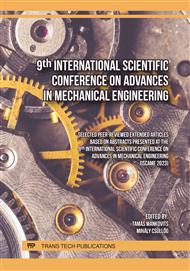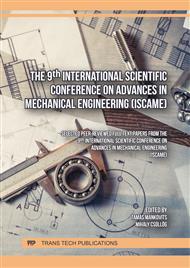p.3
p.11
p.23
p.31
p.39
p.47
p.55
p.65
Investigation of Surface Roughness Determination Problems in Additive Manufacturing Technologies
Abstract:
Besides conventional shaping methods like injection molding and extrusion, various additive manufacturing (AM) techniques have been steadily gaining prominence due to the numerous benefits they offer. These advantages include swift and uncomplicated shaping, the capability to produce components with intricate geometries during both the design and production phases, manufacturability enhancements, and cost-efficiency.In the context of the automotive industry, components produced often need to adhere to stringent standards. When it comes to these manufactured parts, the precision of processing and the quality of the surface represent the paramount complex metrics that dictate the performance attributes of the specific part.The surface roughness of parts produced by 3D printing depends on many factors: from CAD to stl (standard triangular language) conversation and from the chosen method, layer thickness, printing speed, printing temperature.It can be done surface modification by different methods: application of coatings, surface modification procedures (chemical, e.g. etching, physical, e.g. chipping (milling, turning), ironing (software based method)The surface roughness depends also the place of the investigation: Horizontal or vertical walls, sloping surfaces. Surface roughness also varies on the same surface by changing slope due to the staircase effect.Moreover the surface roughness depends on the method of the investigation parallel or perpendicular to the layers and the printing or infill direction.In the last two cases it should be a good choice to use Sa which is the extension of Ra (arithmetical mean height of a line) to a surface. It expresses, as an absolute value, the difference in height of each point compared to the arithmetical mean of the surface.In this paper, we explore this issue
Info:
Periodical:
Pages:
31-37
Citation:
Online since:
July 2024
Authors:
Price:
Сopyright:
© 2024 Trans Tech Publications Ltd. All Rights Reserved
Share:
Citation:



